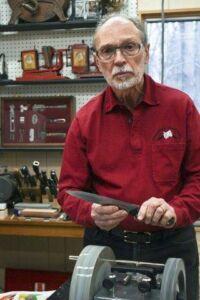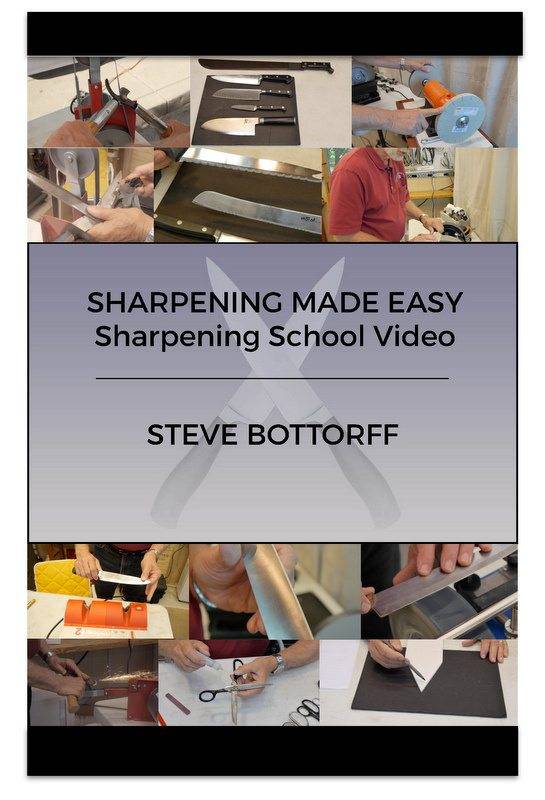Interviews
Interview with Steve Bottorff, Author of Sharpening Made Easy
08.10.2015
Here’s our interview with Steve Bottorff, knife sharpener and author of one of the most popular knife sharpening books ever: Sharpening Made Easy.
“Sharpening has been a rewarding hobby/business for me. Apart from making money, I take satisfaction in solving a sharpening problem, and I enjoy the appreciation the customer shows when he or she realizes what a good sharp edge is again. Often they show up a week later with a cut finger and a story to tell, with a smile still on their face.”
1. Hi Steve. Do you remember the first time you sharpened a knife?
[box size=”large”]When I became a Boy Scout and got my first knife my grandfather taught me to sharpen it. He lived with us and as I recall he was almost 90 years old at the time. He was a country doctor in an era before disposable scalpels and when all doctors performed some surgery. I could not match his scalpel sharpness but it set a standard that I have pursued to this day.[/box]

2. What was the main challenge when you first started sharpening knives?
[box size=”large”]Removing enough metal to get a new edge and then getting rid of the burr. Since then I have learned the importance of using the exit burr (grinding off the edge) for the primary bevel, then using the entrance burr (grinding into the edge) to get rid of it…[/box]
3. Can you tell us more about your sharpening technique?
[box size=”large”]Today I always use a Tormek wet grind for my primary bevel, slow diamond wheels for burr removal and slow ceramic wheels for the final honing. Heat is the #1 enemy of edge live so slower is better. This gives a slicing edge that meets the needs of 95% of my customers. When the customer wants a razor edge, such as on a high-end Japanese knife, I will strop the edge on the slow leather wheel of the Tormek. [/box]
4. How did your sharpening technique develop during the years?
[box size=”large”]I relied on luck to get a good edge for decades. Then I began using rod-guided systems. There is no better way to learn what a proper edge looks and cuts like. Quickly I became an angle fanatic. From there I explored power systems for more speed without giving up quality. I discovered paper sharpening wheels and their fast razor sharp edges. I became a polishing fanatic. The pendulum having swung both ways I am now a moderate. The angle can be off a few degrees and still get a good edge. And if the edge is too polished it will slide when making a slicing cut because there is no “tooth“.[/box]
5. How did sharpening become a business?
[box size=”large”]It began as a hobby. I am an electrical engineer and worked all my life in the test and measurement business, the last 20 years in sales and marketing. I began looking seriously at the sharpening gadgets on the market and in 1999 I wrote an article for Knife World magazine. That article became the basis for my website and I was working on expanding the content when Knife World asked if I would be interested in writing a book for them. Since I was about to retire I said yes. The book was published in 2002 and sales were great immediately. People began to phone and ask if they could study with me, so I opened a school. Then they asked where to buy the equipment I recommended, so I opened an online business. Finally the local farmers market called and asked me if I would sharpen at their market. I protested that I only did it for family and friends and was not set up for retail, but they persisted with an offer of a tent and tables, plus free rent. So I became a sharpener. Except for an occasional gig, I am retired from that now to concentrate on traveling. My book is still available and we have captured the sharpening school on a video so anyone can learn my methods without raveling to Ohio.[/box]

6. Is starting with cheap knives a good idea for beginners? Why?
[box size=”large”]I think a sharpener should sharpen at least 100 knives before he or she goes into business, but they should not all be cheap knives. Cheap knives can mislead because they generally are thin and easy to sharpen. Get a dozen cheap ones and sharpen them 4 times each. That’s half way to your 100. Then start with home, family and friends, asking for feedback as you go. Hopefully you will encounter a chef or other serious knife user who can act as a mentor. Make sure there are a few heavy chefs and hunting knives in the mix. Don’t overlook lodge or church kitchens that would appreciate a free sharpening.[/box]
7. What do you think is the most common mistake beginner knife sharpeners make, and how can they avoid it?
[box size=”large”]There are three common mistakes:
1) Not controlling your angle. Use a jig or fixture.
2) Not removing enough metal to create a new edge. Check for the burr
3) Not getting rid of the burr. Grind into the edge on a fine stone or rod, alternating sides, until burr is gone[/box]
8. How should a beginner start sharpening knives? What do you think should be their first step?
[box size=”large”]Start with a rod-guided system like the Edge Pro or other with a good guide. Avoid pull through gimmicks. And read my book.[/box]
9. Are you still perfecting and improving your sharpening technique today?
[box size=”large”]Yes, I am always looking for new ideas. There is no one right way. I attend a knife show at least once a year and follow the forums. A colleague just invented a jig for faster setting of the knife jigs for the Tormek wet grinder.[/box]









